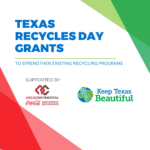Texas Litter Database Office Hours
Join Kirsten Sorensen, KTB’s Research and Cleanups Program Manager, for a review on submitting your data to the Texas Litter Database, and to troubleshoot any issues you may have during your submission. Get your questions answered during this open office hour. Remember, Fall Sweep reporting is due Dec 10th.


